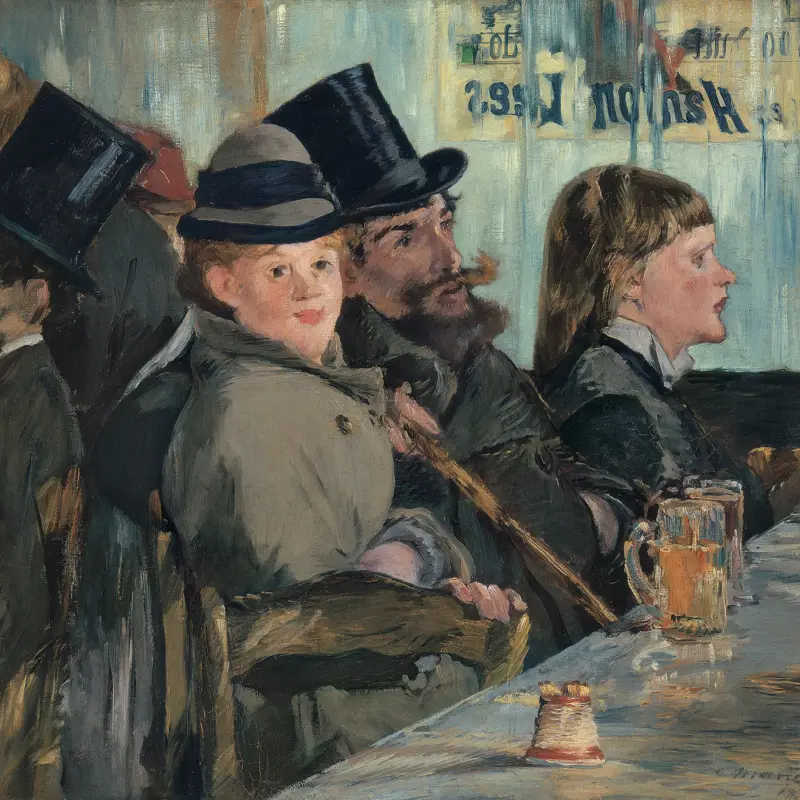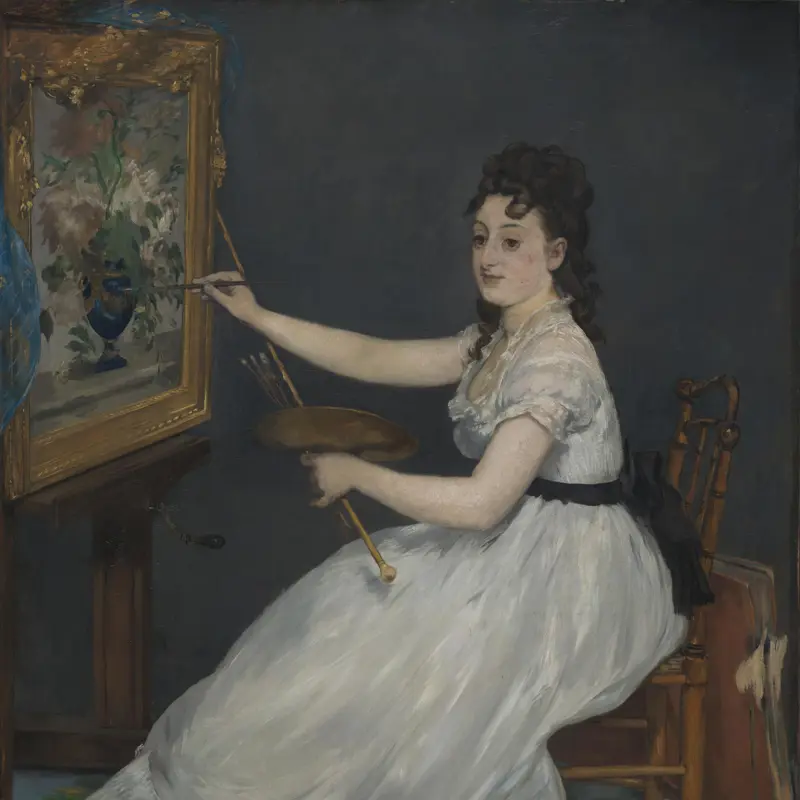Edouard Manet, 'Corner of a Café-Concert', probably 1878-80
About the work
Overview
In August 1877 Manet began work on a large picture of the Brasserie de Reichshoffen, where he was fascinated by the skill of the waitresses. While working on the picture, he radically altered his plans and cut it in two, completing each half separately. This snapshot view of the cafe is the right side of the larger painting. The left half shows a man and two women sitting at the other side of the table. Titled At the Café, that painting is in the Reinhart Collection, Winterthur, Switzerland.
Manet enlarged the National Gallery picture by adding an extra strip of canvas along its right side to bring the waitress into the centre of the composition. Although a painting in its own right, Corner of a Café-Concert is also a fragment. But this is appropriate for its subject, as Manet offers us just a fleeting glimpse into this world, not a panoramic view of it.
Key facts
Details
- Full title
- Corner of a Café-Concert
- Artist
- Edouard Manet
- Artist dates
- 1832 - 1883
- Date made
- probably 1878-80
- Medium and support
- oil on canvas
- Dimensions
- 97.1 × 77.5 cm
- Inscription summary
- Signed; Dated
- Acquisition credit
- Bought, Courtauld Fund, 1924
- Inventory number
- NG3858
- Location
- Room 41
- Collection
- Main Collection
- Frame
- 18th-century French Frame
Provenance
Additional information
Text extracted from the ‘Provenance’ section of the catalogue entry in Martin Davies, with additions and some revisions by Cecil Gould, ‘National Gallery Catalogues: French School: Early 19th Century, Impressionists, Post-Impressionists, etc.’, London 1970; for further information, see the full catalogue entry.
Exhibition history
-
2016Manet: Painting the GazeHamburger Kunsthalle27 May 2016 - 4 September 2016
-
2018Frans Hals and the Moderns: Hals meets Manet, Singer Sargent and Van GoghFrans Hals Museum12 October 2018 - 24 February 2019
-
2019The Courtauld Collection. A Vision for ImpressionismFondation Louis Vuitton20 February 2019 - 17 June 2019
-
2023Masterpieces from the National GalleryShanghai Art Museum East17 January 2023 - 7 May 2023National Museum of Korea2 June 2023 - 9 October 2023Hong Kong Palace Museum22 November 2023 - 11 April 2024Chimei Museum2 May 2024 - 1 September 2024
-
2024In Your Wildest Dreams. Ensor Beyond ImpressionismKoninklijk Museum voor Schone Kunsten Antwerpen (KMSKA)28 September 2024 - 19 January 2025
Bibliography
-
1877'Paris Studios: M. Manet's', The Architect, 1877
-
1880'Chronique', Le Temps, 1880
-
1882P. Eudel, L'Hôtel Drouot et la curiosité en 1881 jusqu'en 1888, 9 vols, Paris 1882
-
1884E. Bazire, Manet, Paris 1884
-
1884F. Fénéon, 'Exposition d'Edouard Manet', La Libre Revue, 1884
-
1884L. Gonse, 'Manet', Gazette des beaux-arts, 1884, pp. 133-52
-
1884Vente Manet', La Chronique des arts, 1884
-
1884J. Péladan, 'Le procédé de Manet d'après l'exposition de l'École des Beaux-Arts', L'Artiste, 1884
-
1884E. Zola et al., Edouard Manet (exh. cat. Ecole nationale des Beaux-Arts, January 1884), Paris 1884
-
1884E. Zola, Exposition des oeuvres de Édouard Manet, Paris 1884
-
1902T. Duret, Histoire de Edouard Manet et de son oeuvre, Paris 1902
-
1909H. Matisse, 'Notizen eines Malers', Kunst und Künstler, 1909
-
1923W. Sickert, 'French Pictures at Knoedler's Gallery', The Burlington Magazine, XLIII/244, 1923, pp. 39-44
-
1923Knoedler Gallery, Exhibition of Nineteenth Century French Painters (exh. cat., Knoedler Gallery, 26 June 1923 - 21 July 1923), London 1923
-
1926E. Moreau-Nélaton, Manet raconté par lui-même, 2 vols, Paris 1926
-
1926Anon., 'Art Purchases for the Nation: The Courtauld Fund: Modern Foreign Paintings', Morning Post, 1926
-
1926C. Bell, 'Les tableaux français modernes à la Galerie Tate et à la Galerie Nationale de Londres', L'Amour de l'art, 1926
-
1926R. Fry, 'The Courtauld Fund', Nation and Athenaeum, 1926, pp. 613-4
-
1926W. McCance, 'The Courtauld Collection', Spectator, 1926
-
1926Paris, Bibliothèque Nationale: Moreau-Nélaton catalogue manuscrits, 1926
-
1931A. Tabarant, Manet: Histoire catalographique, Paris 1931
-
1932P. Jamot, G. Wildenstein and M.-L. Bataille, Manet, Paris 1932
-
1932La bière dans l'œuvre de Manet', L'Amour de l'art, 1932
-
1937J. Laver, French Painting and the XIXth Century, London 1937
-
1939L. Venturi, Les archives de l'impressionnisme, Paris 1939
-
1947A. Tabarant, Manet et ses oeuvres, Paris 1947
-
1948A. Vollard, Souvenirs d'un marchand de tableaux, Paris 1948
-
1948Tate Gallery, Samuel Courtauld: Memorial Exhibition, London 1948
-
1954D. Cooper, The Courtauld Collection: A Catalogue and Introduction, London 1954
-
1955G. Bataille, Manet, Lausanne 1955
-
1955D. Cooper and M. Dreyfus-Bruh, Impressionistes de la Collection Courtauld de Londres, (exh. cat. Musée de l'Orangerie, October 1955 - January 1956), Paris 1955
-
1956L. Venturi, Four Steps Towards Modern Art, New York 1956
-
1957Martin Davies, National Gallery Catalogues: French School, 2nd edn (revised), London 1957
-
1958J. Richardson, Edouard Manet. Paintings and Drawings, London 1958
-
1967S. Orienti and P. Pool, The Complete Paintings of Manet, New York 1967
-
1968M. Bodelsen, 'Early Impressionist Sales 1874-94', The Burlington Magazine, CX/783, 1968, pp. 330-49
-
1970Davies, Martin, and Cecil Gould, National Gallery Catalogues: French School: Early 19th Century, Impressionists, Post-Impressionists etc., London 1970
-
1975D. Rouart and D. Wildenstein, Edouard Manet: Catalogue raisonné, Lausanne 1975
-
1982T. Reff, Manet and Modern Paris: One Hundred Paintings, Drawings, Prints and Photographs by Manet and His Contemporaries (exh. cat. National Gallery of Art, Washington, 5 December 1982 - 6 March 1983), Washington 1982
-
1983D. Bomford and A. Roy, 'Manet's "The Waitress": An Investigation into its Origin and Development', National Gallery Technical Bulletin, VII, 1983, pp. 3-19
-
1983J. Mills and R. White, 'Analyses of Paint Media', National Gallery Technical Bulletin, VII, 1983, pp. 65-7
-
1983National Gallery, 'Pictures Cleaned and Restored in the Conservation Department of the National Gallery, January 1983 – December 1983', National Gallery Technical Bulletin, VIII, 1984, pp. 71-2
-
1983F. Cachin and C.S. Moffett, Manet, 1832-1883 (exh. cat. Grand Palais, 22 April - 1 August 1983; Metropolitan Museum of Art, 10 September - 27 November 1983), Paris 1983
-
1983M. Wilson, Manet at Work: An Exhibition to Mark the Centenary of the Death of Edouard Manet, 1832-1883 (exh. cat. The National Gallery, London, 10 August - 9 October 1983), London 1983
-
1984M. Gifford, 'Manet's at the Café: Development and Structure', Journal of the Walters Art Gallery, XLII-XLIII, 1984, pp. 98-104
-
1986E. Guffey, 'Manet, the Double Bass Player, and the Art of Realism', Stanford Museum, 1986, pp. 14-8
-
1986J. Wilson-Bareau, The Hidden Face of Manet: An Investigation of the Artist's Working Processes (exh. cat. The Courtauld Gallery, 23 April - 15 June 1986), London 1986
-
1988R.L. Herbert, Impressionism: Art, Leisure and Parisian Society, New Haven 1988
-
1989H. Keller, Edouard Manet, Munich 1989
-
1989K. McConkey, British Impressionism, Oxford 1989
-
1990J.-J. Léveque, Les années impressionnistes: 1870-1889, Paris 1990
-
1991H. Clayson, Painted Love: Prostitution in French Art of the Impressionist Era, New Haven 1991
-
1991J. Wilson-Bareau (ed.), Manet by Himself, London 1991
-
1992L. Stevenson, Manet, London 1992
-
1993P.H. Feist, Impressionismus: Die Entdeckung der Freizeit, Leipzig 1993
-
1994J. House, Impressionisim for England: Samuel Courtauld as Patron and Collector, London 1994
-
1994'Art Purchases for the Nation: The Courtauld Fund: Modern Foreign Paintings', in J. House, Impressionism for England: Samuel Courtauld as Patron and Collector, London 1994
-
1994W. McCance, 'The Courtauld Collection', in J. House, Impressionism for England: Samuel Courtauld as Patron and Collector, London 1994
-
1995H. Düchting, Edouard Manet: Images of Parisian Life, Munich 1995
-
1995P. Smith, Impressionism: Beneath the Surface, New York 1995
-
1996R. Pickvance, Manet (exh. cat. Fondation Pierre Gianadda, 5 June - 11 November 1996), Martigny 1996
-
1999M. Foucault, Die Malerei von Manet, Berlin 1999
-
1999S. Lemoine and B. March, Les peintres et la bière, Paris 1999
-
2001
C. Baker and T. Henry, The National Gallery: Complete Illustrated Catalogue, London 2001
-
2002H. Toussaint, Hals and Manet: On Tour from the National Gallery, London (exh. cat. Ashmolean Museum, 2 October - 24 November 2002; Usher Gallery, 30 November 2002 - 2 February 2003; Aberdeen Art Gallery, 8 February - 6 April 2003), Oxford 2002
-
2003M.B. Mena Marqués (ed.), Manet en el Prado (exh. cat. Museo Nacional del Prado, 13 October 2003 - 11 January 2004), Madrid 2003
About this record
If you know more about this work or have spotted an error, please contact us. Please note that exhibition histories are listed from 2009 onwards. Bibliographies may not be complete; more comprehensive information is available in the National Gallery Library.






